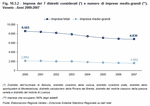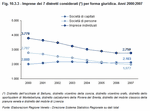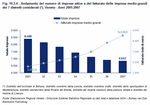In Italy, but especially in Veneto, the formation of production districts is another important form of aggregation and creation of networks of relationships in order to make up for lack of economies of scale due to the small size of firms and to take advantage of the flexibility and socio-economic wealth of SMEs.
The production districts of Veneto are an example of the exploitation of economies of agglomeration that enable a stable division of work among businesses, with the consequent processes of specialisation/integration between autonomous units, without unified control or management being established. Businesses base their strengths on their strategic alliances, collaboration agreements, creation of consortia, systems based on cooperation and coordination between firms and other organisations formed under conditions of interdependence. This interdependence, in turn, "can take place both vertically, in practice along the chain of value creation (for example, between a supplier and a client), and horizontally, that is between firms that perform the same activities and operate in the same environment (for example, two competitors)" (Soda, 1998).
In the 1980s and 1990s and for over half of the first decade of this century, the creation and enhancement of the district system of Veneto represented a winning strategy that allowed the region's industrial system to be competitive in international markets.
The changes in the economic situation through the globalisation of markets and, in particular, the penetration of and spread of products from Asian countries in international markets, have led, however, to disorientation within the closed context of the industrial districts, raising several questions about their efficacy and their future. Several economists have found some weaknesses alongside the strong points of the districts. Despite Veneto's vocation for exports, the learning process tends to remain closed within the local context (Rullani, 2003). This has contributed to keeping production concentrated on a low technological level, to resistance to the growth of large size firms and to maintaining specialisation in manufactured products with a low level of innovation, which are now less competitive than the corresponding Asian products. In a context of rapid technological change, the threshold for financing, and perhaps also for know-how, necessary for the introduction of innovations that involve the entire range of the business world may be beyond the capacities of individual firms in the districts (Onida, Viesti, Falzoni, 1992).
In the light of the effects of the international recession that have struck the entire business world over the last year, it is interesting to ask how the district system will behave, how will it react to new challenges, to technological changes, and whether it will be able to take advantage of other factors to overcome the crisis. The purpose of this section is not to answer these questions, but to show by the analysis of the available data that there are signs of changes that may lead to positive developments.
Seven of Veneto's long-standing industrial districts have been considered
(Note 1) by integrating the information in several databases, both statistical and administrative, to analyse the circumstances of these districts from a structural and financial point of view. The chosen districts are: the eyewear district of Belluno; the tanning district of Vicenza; the goldsmithing district of Vicenza; the sportsystem district of Montebelluna; the footwear district of the Riviera del Brenta; the classic furniture district of the Veneto plain; and the furniture district of Livenza
(Note 2).
From the analysis carried out, one of the critical signals is the negative trend in the number of businesses in each district over time: despite each one having its own different dynamics, overall, from 2000 to 2007, a decline of 20% in active businesses and of 9.7% in the number of employees was found. Although all of the districts considered recorded a decrease in the number of businesses over the 8 years considered, some of these saw a growth in the number of employees, as in the tanning district of Vicenza, the eyewear district of Belluno and the furniture district of Livenza.
Considering the businesses by number of employees, it can be seen that the decrease in the number of the smaller businesses has been more rapid than for larger ones: from 2000 and 2007 the businesses with between 1 and 4 employees decreased by 19%, while those with more than 100 employees fell by 7.4%.
(Figure 10.3.1).
To understand how much size influences performance, processing has been carried out for both the entire population and for the larger firms of the districts, which were identified using the Pareto principle (the principle of factor sparsity); it can be summarised by saying that most of the effects are due to a limited number of causes
(Note 3). This principle was found to be met in district systems as well: about 80% of the employees work in 20% of the businesses.
The businesses that employ 80% of the workers were identified and their dynamics studied over time; even though in this case there is a clear overall decrease in the importance of districts, however in terms of employment, it is less marked. From 2000 to 2007 these businesses declined by 8.9%, with the exceptions of the eyewear district and the furniture district of Livenza.
(Figure 10.3.2).
These figures should be placed alongside the overall increase in corporations; the 5.2% increase in enterprises with this form of ownership would seem to suggest a situation of business change and restructuring through the incorporation of smaller firms into more complex units.
(Figure 10.3.3).
After having highlighted the trends and dynamics of district firms from the perspective of size and demography, the analysis evaluated the performance of firms from an economic-financial perspective, through looking at the appropriate financial statement indices.
Profitability of shareholder capital (ROE
(Note 4)) shows a fluctuating trend over time and in most cases it fell. The districts that had a higher profitability were the footwear district on the Riviera del Brenta and the sportsystem district of Montebelluna. The profitability of business operations (ROA
(Note 5)) shows a rather constant trend, except in the district of the Riviera del Brenta, in which it increased, and that of goldsmithing, in which it decreased. Regarding their financial standing, it can be concluded that leverage in all districts is rather high, despite it decreasing in some districts, especially in tanning and in footwear; in others it has a upside down U-shape, with a peak in the central years of the analysis for eyewear, classic furniture and furniture. The difference between returns and spread is positive especially in the sportsystem and in footwear, while in some it is negative, indicating it is inconvenient to take on further debt (eyewear, tanning and goldsmithing). Liquidity in the short-term, however, is satisfactory in all districts.
Thus no generalisation can be made about the performance of the districts, because the findings were quite varied; however several persistent, common aspects were found, such as a generally high debt burden and the realisation of satisfactory returns, that is sufficient to cover their financing, especially the availability of sufficient short-term liquidity in the districts.
A final result, one that may be seen as a summary and combination of the demographic trends examined above and the economic performance of the districts, was in the trend in the turnover of medium-large size businesses and the number of active businesses in the period from 2000 and 2007
(Note 6). To establish whether a business may be considered medium-large, a size threshold of a turnover greater than 10 million euro in 2007 was chosen
(Note 7). Once the businesses meeting the threshold had been identified, it was observed whether the performance of these businesses, which are considered more structured, improved or worsened over time.
The result is quite clear: despite the fact that the stock of active businesses decreased, those of a larger size constantly increased their turnover, and this is surely a positive and comforting sign for this kind of company, since the average turnover for all firms, instead, declined.
(Figure 10.3.4),
(Figure 10.3.5),
(Figure 10.3.6),
(Figure 10.3.7),
(Figure 10.3.8),
(Figure 10.3.9),
(Figure 10.3.10) and
(Figure 10.3.11)
This finding offers much food for thought: the larger firms, even though they represent a reduced set of the population studied, are growing and probably play a leading role in guiding the district toward transformation and reorganisation.
What is hoped for is not to substitute Veneto's production system with another completely foreign one, but to look to remove those obstacles that make it more complicated for this system to adapt its characteristics and strengths (Omiccioli, 2009).















